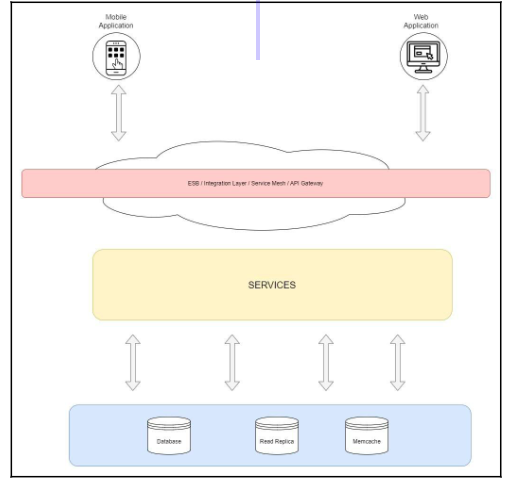Is SOA still relevant in today’s world of microservices and cloud-native architectures? Yes, it is a resounding yes! Despite the emergence of newer approaches, SOA remains a fundamental principle for developing loosely coupled, interoperable systems. This blog will look at how SOA can coexist with and complement these modern trends, allowing you to create the best architecture for your needs.
Tech architectures come in a variety of flavors, each serving a specific purpose and meeting a different set of requirements. Let’s divide the landscape into two major categories to help you navigate it:
1.Architecture Levels:
These define the architecture’s scope and focus:
- Enterprise Architecture (EA): The big picture, encompassing all of an organization’s information technology systems, from core applications to data architecture and integration strategies. Consider it a blueprint for the entire IT landscape.
- Solution Architecture (SA): Is concerned with designing specific solutions within the EA to meet the needs of individual applications, systems, or components. It delves deeper into the “how” of specific functionalities within the context of the overall picture.
- Architecture of Technology (TA): The nuts and bolts, detailing the specific technologies, platforms, and frameworks used to build and deploy the higher-level applications and systems. You’ll come across programming languages, databases, and cloud platforms here.
2.Architectural Styles:
These are the patterns and structures that are used to organize components within an architecture:
- Service-Oriented Architecture (SOA): This popular design is based on independent services communicating loosely via standardized interfaces. Consider it modular units that connect like Lego blocks.
- Microservices Architecture: Microservices, a more granular approach than SOA, divide systems into smaller, self-contained services that can be developed, deployed, and scaled independently. Instead of one large department store, imagine a collection of small, specialized shops working together.
- Monolithic Architecture: The traditional “all-in-one” approach in which a single application contains all functionalities. Consider it a self-contained structure with everything under one roof.
- Client Server Architecture: A two-tiered model in which a dedicated server delivers resources and services to thin clients (typically desktops or mobile devices). Consider a waiter taking customers’ orders and bringing them food from the kitchen.
- Event-Driven Architecture (EDA): Instead of being driven by a predefined sequence, applications react to events. Consider it similar to a newsfeed in which you react to what appears rather than following a predetermined script.
In this blog, we’ll focus mainly on SOA, so let’s start our journey together
SOA is a software design style that emphasizes the creation of applications as a collection of loosely coupled services. These services are self-contained functional units that provide well-defined business capabilities and can be accessed and consumed by other applications via a standard set of
standards and protocols.Here’s a rundown of the key SOA concepts:
Services:
- Independent functional units that carry out specific tasks.
- Interfaces are well-defined and encapsulated.
- Other applications can access and consume it over a network.
Loose Coupling:
- Services are self-contained and do not require knowledge of the internal workings of other services.
- This increases the flexibility and ease of maintenance of applications.
Standards and Protocols:
- Common standards and protocols, such as SOAP, REST, and XML, are used by services to communicate with one another.
- As a result, services can be used with a variety of platforms and technologies.
To help you understand SOA, consider the following analogy:
Consider a restaurant to be a SOA application. The kitchen is a food preparation service. The waitstaff are customers who order food from the kitchen. The kitchen does not need to know who the wait staff is or what they will do with the food. It only needs to provide the food requested by the waitstaff.
Similarly, SOA services do not need to know who their customers are or what they intend to do with the data they provide. They only need to provide the information that their clients require.
SOA Benefits:
- Flexibility: SOA applications are more adaptable to changing business requirements.
- Agility: New services can be quickly and easily added to existing applications.
- Scalability: To meet demand, SOA applications can be easily scaled up or down.
- Reusability: Services can be reused in multiple applications, which reduces development time and costs.
Here are some key scenarios where SOA is a particularly advantageous approach:
1. Heterogeneous System Integration:
- When it comes to connecting disparate systems, technologies, and platforms that weren’t designed to work together seamlessly, SOA shines.
- It enables services to interact regardless of their underlying implementation by providing a common communication layer and standards-based interfaces.
- Example : Integrating a legacy mainframe system with a modern web application or connecting systems across departments or business units.
2. Implementing Reusable Functionality:
- SOA promotes the creation of self-contained, modular services that can be reused across multiple applications and projects.
- This reduces development time and costs while also encouraging consistency and standardization within IT systems.
- Example : Creating a common authentication service used by multiple applications, or a customer data service shared across multiple business processes.
Example of SOA :

Above diagram shows different layers of SOA..
Mobile & Web Application
This layer contains the mobile and web applications. This is the layer from which the consumer or user interacts with our system.
Integration Layer
The integration layer also known as Enterprise Service Bus(ESB) is the major component of Service Oriented Architecture(SOA). It serves as the hub of communication between different services of application.
The concept of Service Mesh or API Gateway also falls under the Integration layer. The primary purpose of using integration layer is to abstract our service layer from consumer reach. In this way we can decouple our services within our system and make our application more robust.
Key Responsibilities of the Integration Layer:
- Service Routing and Mediation: The integration layer serves as a traffic controller, directing incoming requests to the correct service provider. It routes traffic based on a variety of factors, including service capabilities, message types, and security credentials.
- Protocol Translation and Transformation: The integration layer serves as a link between services that use different protocols or data formats. It converts messages into a common format, allowing for seamless communication between disparate systems.
- Message Enrichment and Transformation: The integration layer can transform messages to meet the specific needs of the target service. This could include data validation, enrichment, or filtering.
- Error Handling and Fault Tolerance: The integration layer implements mechanisms to handle errors and exceptions that may occur during service interactions. It ensures that service failures do not cascade and disrupt the overall system.
Service Layer
A key element of a service-oriented architecture (SOA) is the service layer, which acts as the central repository for distinct, self-contained services. By encapsulating the SOA’s business logic and functionality, it allows applications to communicate with services via standardized interfaces as opposed to directly accessing the implementation details down below.
All our services are isolated from each other and communicate with each other through web services. So even if any of our service breaks down our other services will continue to work normally.
Key Characteristics of the Service Layer:
- The service layer is responsible for defining and encapsulating business functionalities into discrete services. These services have well-defined interfaces that encompass operations, data formats, and protocols. This encourages reusability and modularity.
- Service Registration and Discovery: Clients can find and engage with services that are available thanks to the mechanisms for service registration and discovery provided by the service layer. This makes service integration easier and allows for dynamic service invocation.
- Service Orchestration: To complete intricate business processes, the service layer facilitates the orchestration and choreography of services. Whereas choreography entails decentralized coordination between services, orchestration entails centralized control over service invocation.
Database Layer
The database layer is critical in the context of service-oriented architecture (SOA) in providing permanent storage and data management capabilities for SOA applications. It is the repository for the data that SOA services use to conduct their business functions.
The database layer may include a data store (which may be relational or non-relational depending on the data type), a read replica, which is primarily used as a backup to our existing database, and occasionally a memcache, which serves as a caching layer within our application.
Key Responsibilities of the Database Layer:
- Data Storage and Management: The database layer stores and manages the data utilized by SOA services. It provides means for structured and efficient data storage, retrieval, updating, and deletion.
- Data Integrity and Consistency: By enforcing data validation criteria, preventing data anomalies, and ensuring data consistency across many services, the database layer ensures data integrity and consistency.
- Data Access and Security: The database layer manages data access by enforcing authentication and permission processes. It controls sensitive data access and safeguards against illegal access and data breaches.
SOA offers limitless opportunities. As technology advances, so will our understanding of this powerful architecture. So stay tuned, keep exploring, and remember that the only limit in the world of SOA is your imagination.
References:
https://martinfowler.com/microservices/https://docs.aws.amazon.com/whitepapers/latest/microservices-on-aws/microservices-on-aws.html




